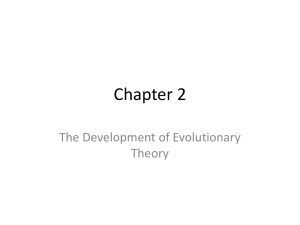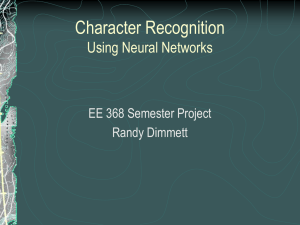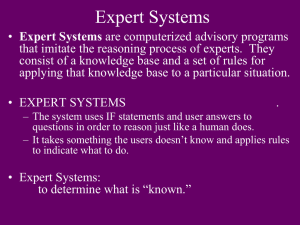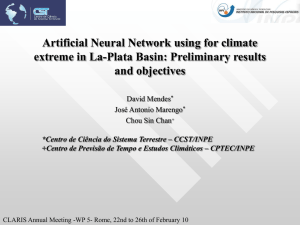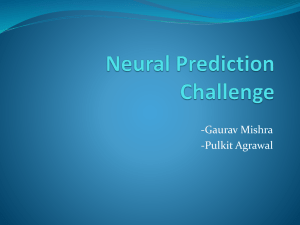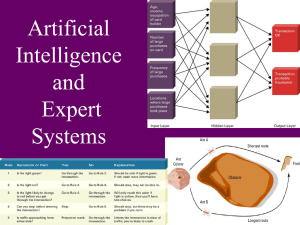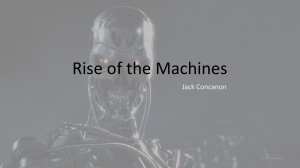ALGORITHMICS
advertisement
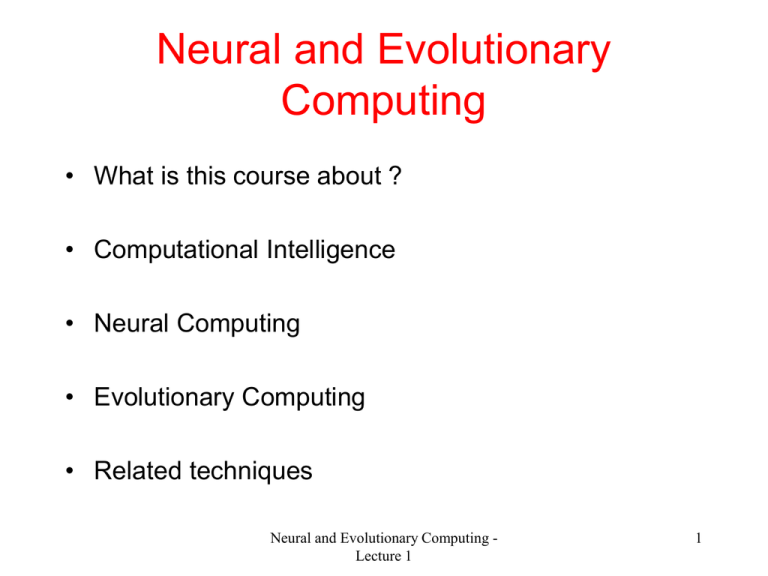
Neural and Evolutionary Computing • What is this course about ? • Computational Intelligence • Neural Computing • Evolutionary Computing • Related techniques Neural and Evolutionary Computing Lecture 1 1 What is this course about ? • As almost all courses in Computer Science it is about problem solving • Its main aim is to present techniques to solve hard problems • There are problems which are hard: – both for humans and computers (e.g. large combinatorial optimization problems, multimodal / multiobjective optimization problems etc) – computationally hard problems – for computers but rather easy for humans (e.g. character recognition, face recognition, speech recognition etc) – ill posed problem Neural and Evolutionary Computing Lecture 1 2 Computationally hard problems • Problems characterized by a large space of solutions for which there are no exact methods of polynomial complexity (so-called NP hard problems) – they are characterized by a huge size search space (which cannot be exhaustively searched) Examples: – Satisfiability problem (SAT): find the values of boolean variables for which a logical formula is true. For n variables the search space has the size 2n – Travelling Salesman Problem (TSP): find a minimal cost tour which visits n towns. The search size is (n-1)! (in the symmetric case, it is (n-1)!/2) Neural and Evolutionary Computing Lecture 1 3 Ill-posed problems • The particularity of problems which are easy for humans but hard for computers is that they are ill-posed, i.e. there is difficult to construct an abstract model which reflects all particularities of the problem • Let us consider the following two problems: – Classify the employees of a company in two categories: first category will contain all of those who have an income larger than the average salary per company and the second category will contain the other employees – Classify the employees of a company in two categories: first category will contain all those which are good candidates for a bank loan and the second category will contain the other employees Neural and Evolutionary Computing Lecture 1 4 Ill-posed problems • In the case of the first problem there is easy to construct a rulebased classifier: IF income > average THEN Class 1 ELSE Class 2 • In the case of the second problem it is not so easy to construct a classifier because there are a lot of other interrelated elements (health status, family, career evolution etc) to be taken into account in order to decide if a given employee is reliable for a bank loan. A bank expert relies on his experience (previous success and failure cases) when he makes a decision Neural and Evolutionary Computing Lecture 1 5 Ill-posed problems • Differences between well-posed and ill-posed problems: Well-posed problems: - There is an abstract model which describes the problem - Consequently, there is a solving method, i.e. an algorithm Ill-posed problems: - They cannot be easily formalized - There are only some examples for which the results is known - The data about the problem could be incomplete or inconsistent - Thus, traditional methods cannot be applied Neural and Evolutionary Computing Lecture 1 6 Ill-posed problems The methods appropriate for ill-posed problems should be characterized by: • Ability to extract models from examples (learning) • Ability to deal with dynamic environments (adaptability) • Ability to deal with noisy, incomplete or inconsistent data (robustness) • Ability to provide the answer in a reasonable amount of time (efficiency) The field dealing with such kind of methods is called “computational intelligence” or “soft computing” Neural and Evolutionary Computing Lecture 1 7 Computational Intelligence and Soft Computing Computational Intelligence “is a branch of the study of artificial intelligence; it aims to use learning, adaptive, or evolutionary algorithms to create programs that are, in some sense, intelligent. “ [Wikipedia] “it deals with the study of adaptive mechanisms which allow the simulation of the intelligent behaviour in complex and/or dynamic environments” Soft Computing “is a collection of new techniques in computer science, especially in artificial intelligence; unlike hard computing, it is tolerant of imprecision, uncertainty and partial truth. In effect, the role model for soft computing is the human mind. The guiding principle of soft computing is: exploit the tolerance for imprecision, uncertainty and partial truth to achieve tractability, robustness and low solution cost.” [Wikipedia] Neural and Evolutionary Computing Lecture 1 8 Computational Intelligence Main components: Tool/technique Inspiration source: Neural Computing Artificial Neural Networks Evolutionary Algorithms Human brain Evolutionary Computing Granular Computing Fuzzy Sets/Rough Sets/ Probabilistic Reasoning Biological evolution Human reasoning and natural language CI covers all branches of science and engineering that are concerned with understanding and solving problems for which effective traditional algorithms do not exist. Neural and Evolutionary Computing Lecture 1 9 Computational Intelligence and Natural Computing Natural computing = methods inspired by the nature way of solving problems Neural Computing Bio-inspired meta-heuristics ImmunoComputing DNA Computing Evolutionary Computing Membrane Computing Quantum Computing Granular Computing Probabilistic Methods Granular Computing Neural and Evolutionary Computing Lecture 1 10 Computational Intelligence [A. Konar – Computational Intelligence, 2007] Neural and Evolutionary Computing Lecture 1 11 Computational Intelligence [A. Konar – Computational Intelligence, 2007] Neural and Evolutionary Computing Lecture 1 12 Neural Computing Basic principles The biological model Elements of an artificial neural network Classes of neural networks Applications Neural and Evolutionary Computing Lecture 1 13 Neural Computing Traditional problem solving approach (appropriate for well-defined problems) Input data Algorithm = sequence of well defined operations Result Neural and Evolutionary Computing Lecture 1 14 Neural Computing The neural (machine learning) approach: Examples Learning Input data Neural Network = Adaptive (trainable) system consisting of many interconnected simple functional units Result Neural and Evolutionary Computing Lecture 1 15 Neural Computing Human brain cca 1010 neurons, cca 1014 connections Neural and Evolutionary Computing Lecture 1 16 Artificial neural networks ANN = set of interconnected functional units Functional unit = input connections + aggregation function + activation function Aggregation function inputs x1 w1 xj wj xn wn n output y Weighted connections y f ( w j x j w0 ) j 1 f (u ) sgn(u ) f (u ) tanh(u ) f (u ) H (u ) 1 f (u ) 1 exp(u ) activation functions Neural and Evolutionary Computing Lecture 1 17 Artificial neural networks ANN components: - Architecture - Functioning - Learning: find the adaptive weights N1 2 N 0 1 yi f wik f wkj x j , i 1, N 2 k 0 j 0 A feedforward neural network Neural and Evolutionary Computing Lecture 1 18 Artificial neural networks Neural networks variants: Multilayer perceptron Kohonen network Hopfield model Cellular neural network Neural and Evolutionary Computing Lecture 1 19 Artificial neural networks Learning = process of extracting a (computational) model from examples = compute the adaptive parameters (weights) of the network Learning variants: • Supervised (with a teacher): use the difference between the desired (correct) output and the actual output of the network to compute the adjustments of the adaptive weights • Unsupervised (without a teacher): use only the correlations between input data (no knowledge of the correct answer) • Reinforcement: use reward and penalty values to adjust the weights (no use of the difference between the correct and actual outputs) Neural and Evolutionary Computing Lecture 1 20 ANN applications • Classification – Supervised and unsupervised classification of data – Character/image/speech recognition • Approximation – Estimate the relationship between different variables (e.g. estimate the software projects effort based on software size, …) • Prediction – Extract time series models from data (e.g. predict de evolution of the exchange rate, …) • Control – Nonlinear systems modelling • Optimization – Electronic circuits design • Signal analysis – Adaptive filters Neural and Evolutionary Computing Lecture 1 21 Evolutionary Computing Basic principles The structure of an Evolutionary Algorithm Traditional classes of Evolutionary Algorithms Applications of Evolutionary Computing Neural and Evolutionary Computing Lecture 1 22 Evolutionary Computing • It is inspired by the biological evolution; it stands on the principles of Darwin’s natural evolution theory: genetic inheritance and survival of the fittest • The solution of a problem is identified by searching the solution space using a population of agents (individuals or chromosomes) • The elements of the population are encoded depending on the particularities of the problem (strings of binary or real values, trees, graphs etc) Neural and Evolutionary Computing Lecture 1 23 Evolutionary Computing There is an analogy between the evolution in nature and problem solving Natural Evolution Environment Individual Fitness Problem Solving Problem Potential solution Solution quality Neural and Evolutionary Computing Lecture 1 24 Structure of an EA solution Population initialization Stopping condition Evaluation Selection Recombination, mutation EA = Iterative process based on the sequential application of several operators: - recombination (crossover) - mutation - selection on a randomly initialized population Neural and Evolutionary Computing Lecture 1 25 EA classes • Genetic Algorithms (GA): – – – – Binary encoding of population elements The main operator is the recombination (crossover) The mutation is applied with a small probability Appropriate for combinatorial optimization problems (search in discrete spaces) • Evolution Strategies (ES): – Real encoding of population elements – The main operator is the mutation – Appropriate for solving optimization/search problems over continuous domains Neural and Evolutionary Computing Lecture 1 26 EA Classes • Genetic Programming (GP): – The population elements are computational structures (tress, arithmetical/logical expressions, programs etc.) – Appropriate for evolutionary design of computational structures (programs, circuits etc) • Evolutionary Programming (EP): – Real encoding of population elements – The mutation is the only operator – Used to solve optimization problems on continuous domains Current variants: hybrid techniques Neural and Evolutionary Computing Lecture 1 27 Classes of optimization problems • Constrained and unconstrained optimization – Non-differentiable or discontinous functions or functions without a closed form (their evaluation is based on simulations) – Such kind of problems frequently appear in engineering design and in planning • Multimodal optimization – For functions having many local/global optima – Typical for industrial design • Multiobjective optimization – There are several conflicting objectives to be optimized – Typical for industrial design, data analysis and decision making • Optimization in dynamic and/or noisy environments – The optimization criteria changes in time or its evaluation is influenced by random factors Neural and Evolutionary Computing Lecture 1 28 Applications • Planning (e.g. timetabling, tasks scheduling) • Prediction (e.g. currency exchange rate evolution) • Data and image analysis • Structure prediction (e.g. protein structure prediction starting from the aminoacids sequence) • Neural networks design • Evolutionary art Neural and Evolutionary Computing Lecture 1 29 Related techniques • Models inspired by the intelligence of swarms PSO – Particle Swarm Optimization (Eberhart, Kennedy -1995) http://www.swarmintelligence.org/ http://www.particleswarm.info/ – They are inspired by birds flocking, fish schooling, bees swarms and the behaviour of other “social” entities – During the search process each individual is guided by: • The collective experience • The individual Experience – Applications: • Optimization • Control (nano robots used in medicine) • Creating complex interactive environments (in games or cartoons) Neural and Evolutionary Computing Lecture 1 30 Related techniques • Ant based models ACO – Ant Colony Optimization (M. Dorigo, 1992) [http://iridia.ulb.ac.be/~mdorigo/ACO/ACO.html] AS – Ant Systems – They are inspired by the behaviour of ant colonies when they search for food or organize their nest – Stigmergy is a main concept which expresses the indirect communication between ants by using the pheromone trails Applications: - Optimization (routing problems) - Planning (allocation problems) - Data analysis (clustering) - Image classification Neural and Evolutionary Computing Lecture 1 31 Related techniques • Immune Systems Model AIS– Artificial Immune Systems (L. Castro, 1999) [http://www.dca.fee.unicamp.br/~lnunes/immune.html] – It is inspired by the ability of the biological immune systems to recognize the pathogen agents and to react to an attack Applications: - Intruder Detection Systems - Multimodal optimization - Data mining (clustering) Neural and Evolutionary Computing Lecture 1 32 Related techniques • DNA (molecular) Computing First approach: Adleman’s experiment (1994) – solving the TSP problems for 7 towns by using tools from molecular biology Current status: – – – autonomous biomolecular computer of molecular scale (2004) a superthin computer of just two molecules thick has been designed (it generates various patterns) (2010) Algorithms inspired by operations on DNA structures (splicing, cloning, filtering) A DNA computer is basically a collection of specially selected DNA strands whose combinations will result in the solution to some problem Neural and Evolutionary Computing Lecture 1 33 Related techniques • Membrane Computing (P-systems) [http://ppage.psystems.eu] • • First model: P-systems proposed by Gh. Paun (1998) A P system is a computing model which abstracts from the way the alive cells process chemical compounds in their compartmental structure. They process multisets of symbol objects placed in a hierarchically structured system of membranes (inspired by the structure of cells) Many theoretical results concerning their computation power but less practical applications (however there are reported applications in applications, in biology, linguistics, computer science, management) • • Neural and Evolutionary Computing Lecture 1 34 Related techniques • Artificial Bee Colony (Karaboga, 2005) http://mf.erciyes.edu.tr/abc/ – Inspired by the artificial behavior of honey bees • Biogeography Based Optimization (BBO Algorithms) - D. Simon, 2008 http://academic.csuohio.edu/simond/bbo/ Inspired by geographical distribution of biological organisms • Fireflies Algorithm (X.S. Yang, 2008) – inspired by the flashing behaviour of fireflies • Cuckoo Search (X.S. Yang & S. Deb, 2009) – Inspired by the habits of some cuckoo species to lay their eggs in the nests of other birds • Bat Algorithm (X.S. Yang & A.H Gandomi, 2010) – Inspired by echolocation abilities of bats Neural and Evolutionary Computing Lecture 1 35 Course structure • Artificial Neural Networks for classification, approximation, prediction, optimization – Feedforward neural networks (BackPropagation, Radial Basis Functions) – Recurrent neural networks (Hopfield model) • Random optimization algorithms – Random Search – Simulated annealing • Evolutionary algorithms – – – – – – • Genetic algorithms Evolutionary strategies Evolutionary and Genetic Programming Evolutionary algorithms for multi-objective optimization Evolutionary design Parallel and distributed evolutionary algorithms Related techniques: PSO (particle swarm optimization), ACO (ant colony optimization), AIS (artificial immune systems), DE (differential evolution), EDA (estimation of distribution algorithms) etc Neural and Evolutionary Computing Lecture 1 36 Lab structure Lab 1: Classification problems (pattern recognition) feedforward NN Lab 2: Approximation and prediction problems – feedforward NN Lab 3: Combinatorial optimization problems – Simulated Annealing, Genetic Algorithms Lab 4: Continuous optimization problems (nonlinear programming)- Evolution Strategies Lab 5: Evolutionary design problems - Genetic Programming Lab 6: Multiobjective optimization problems - MOEA Lab 7: Applications of related techniques (ACO, PSO, AIS) Testing environments: MATLAB (NN Toolbox, GA Toolbox) Weka Neural and Evolutionary Computing Lecture 1 37 References Course materials: http://web.info.uvt.ro/~dzaharie/nec2012 References: A.Engelbrecht: Computational Intelligence. An Introduction, John Wiley and Sons, 2007 L. Rutkowski: Computational Intelligence: Methods and Techniques, Springer, 2008 A.Konar: Computational Intelligence: Principles, Techniques and Applications, Springer, 2005 Z. Michalewicz, D. Fogel: How to Solve It. Modern Heuristics. Springer, 1999 Neural and Evolutionary Computing Lecture 1 38 Evaluation Grading: Project: 60-80% Written test (open books): 20% Lab activity: 20% Neural and Evolutionary Computing Lecture 1 39

